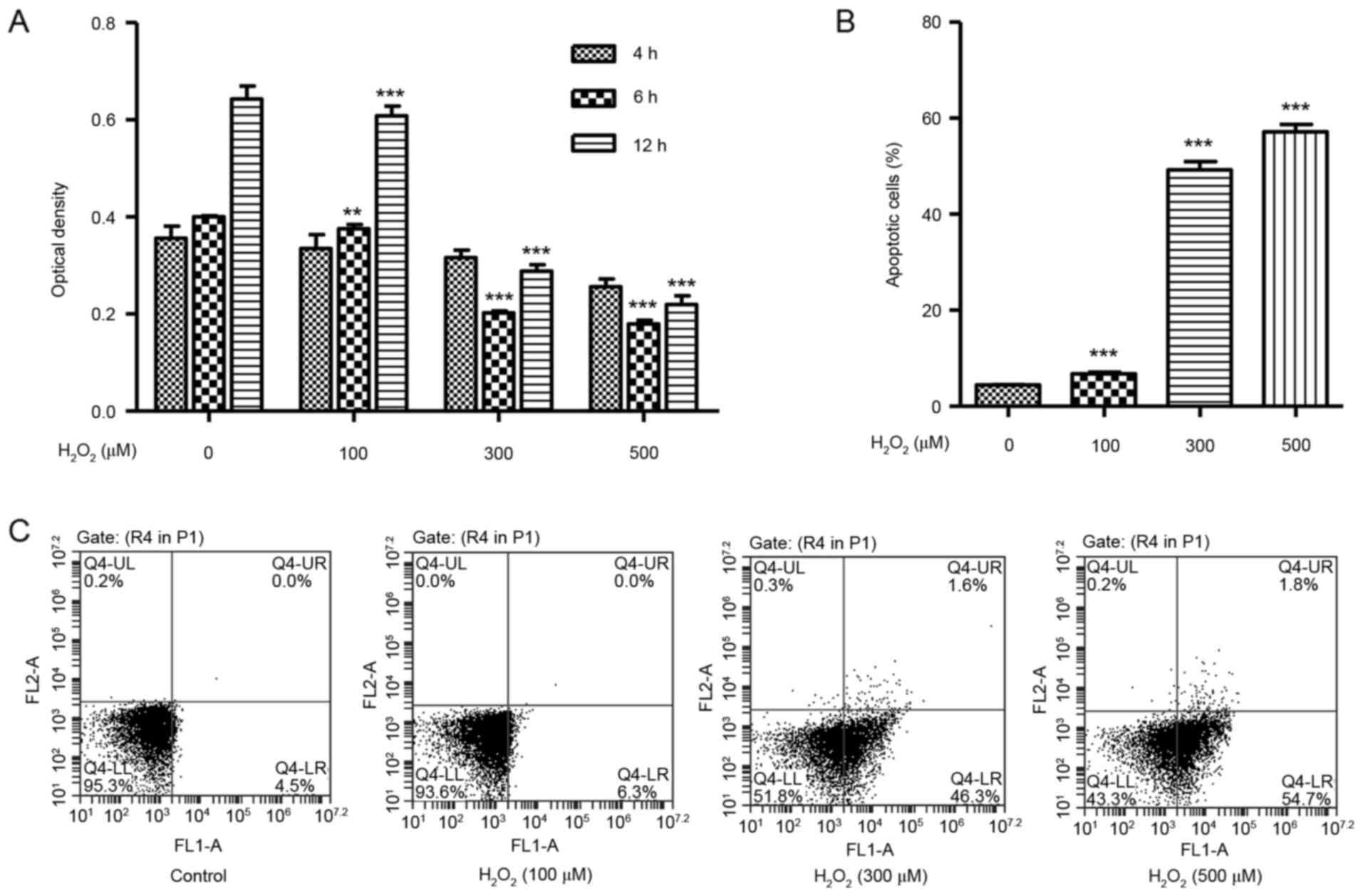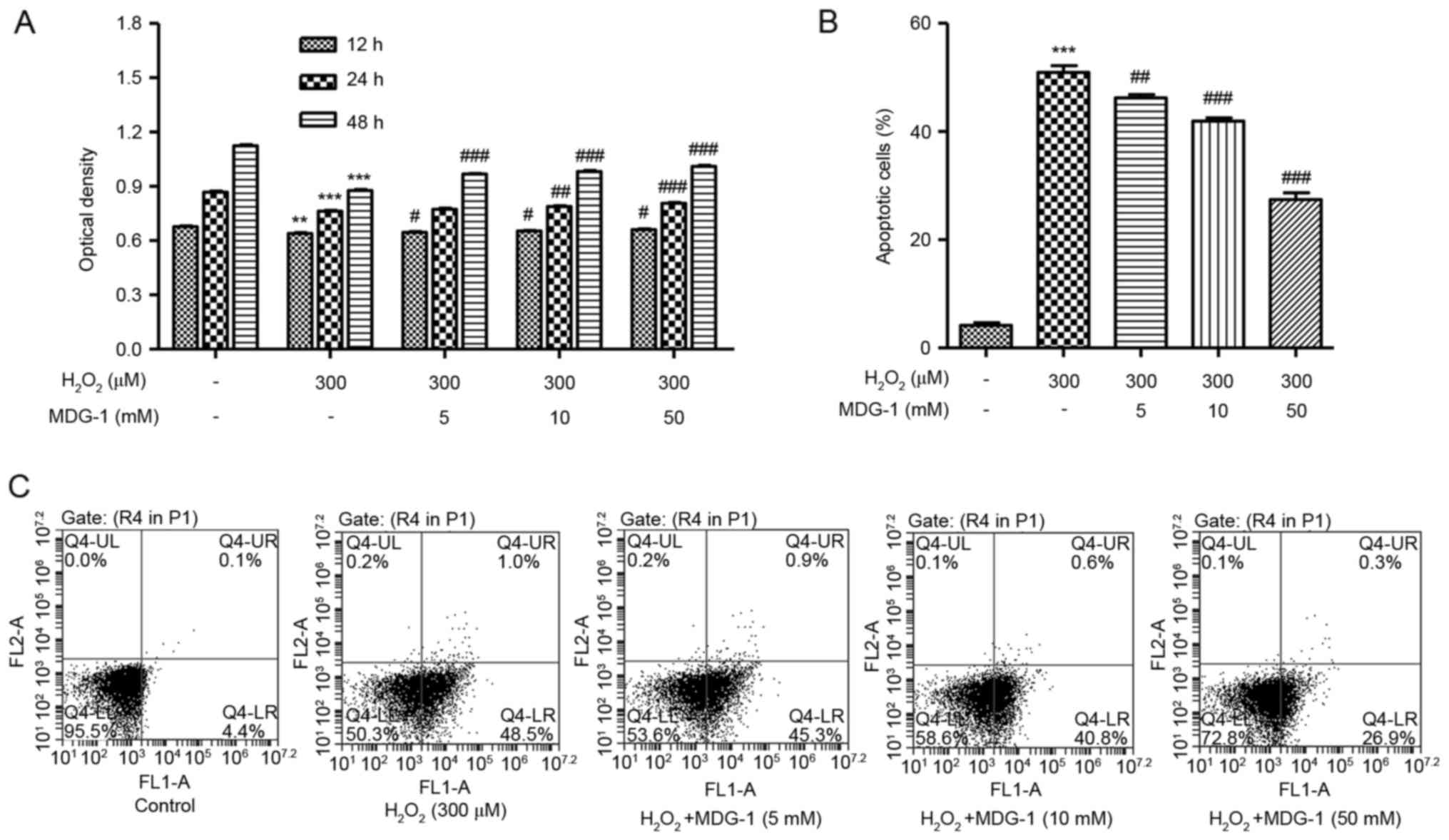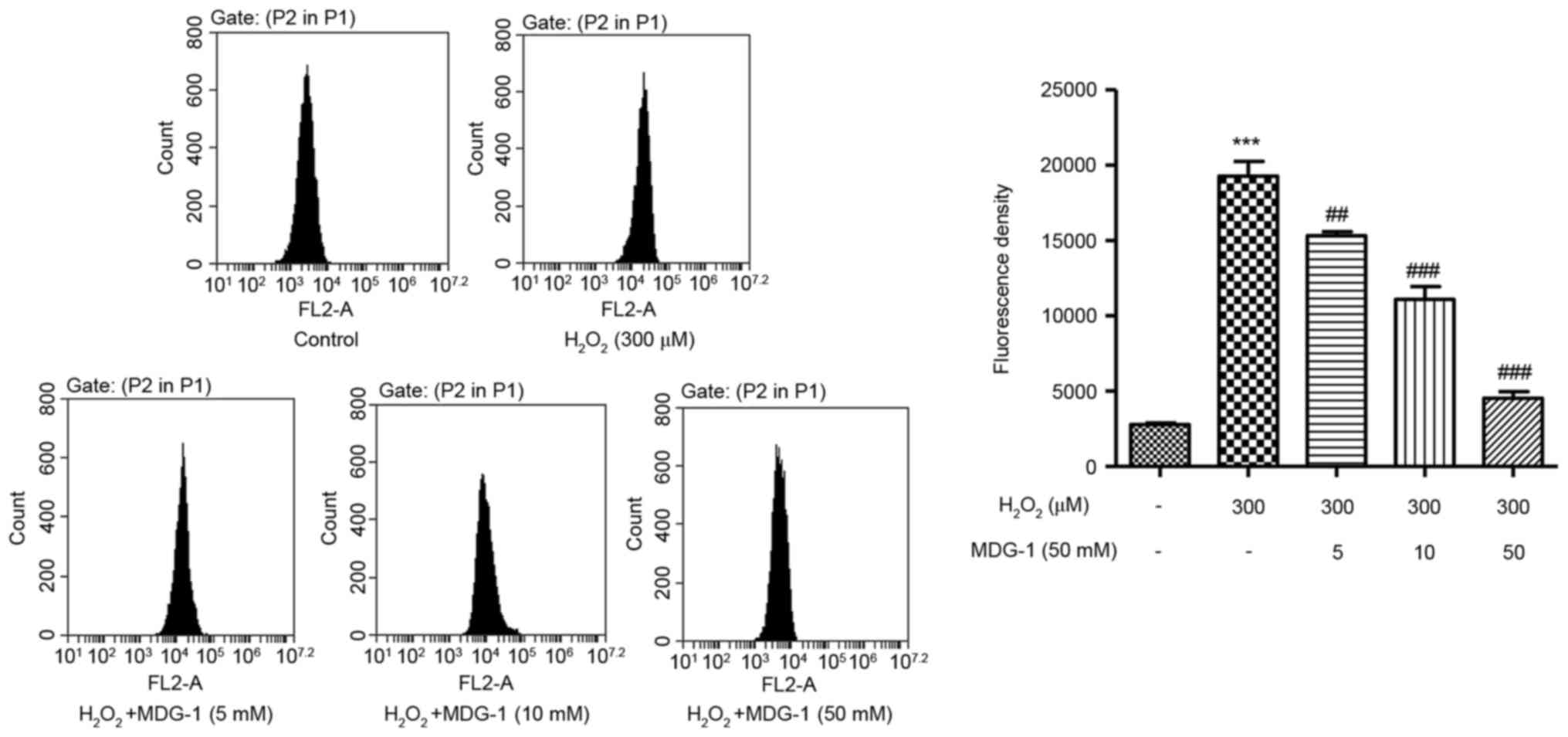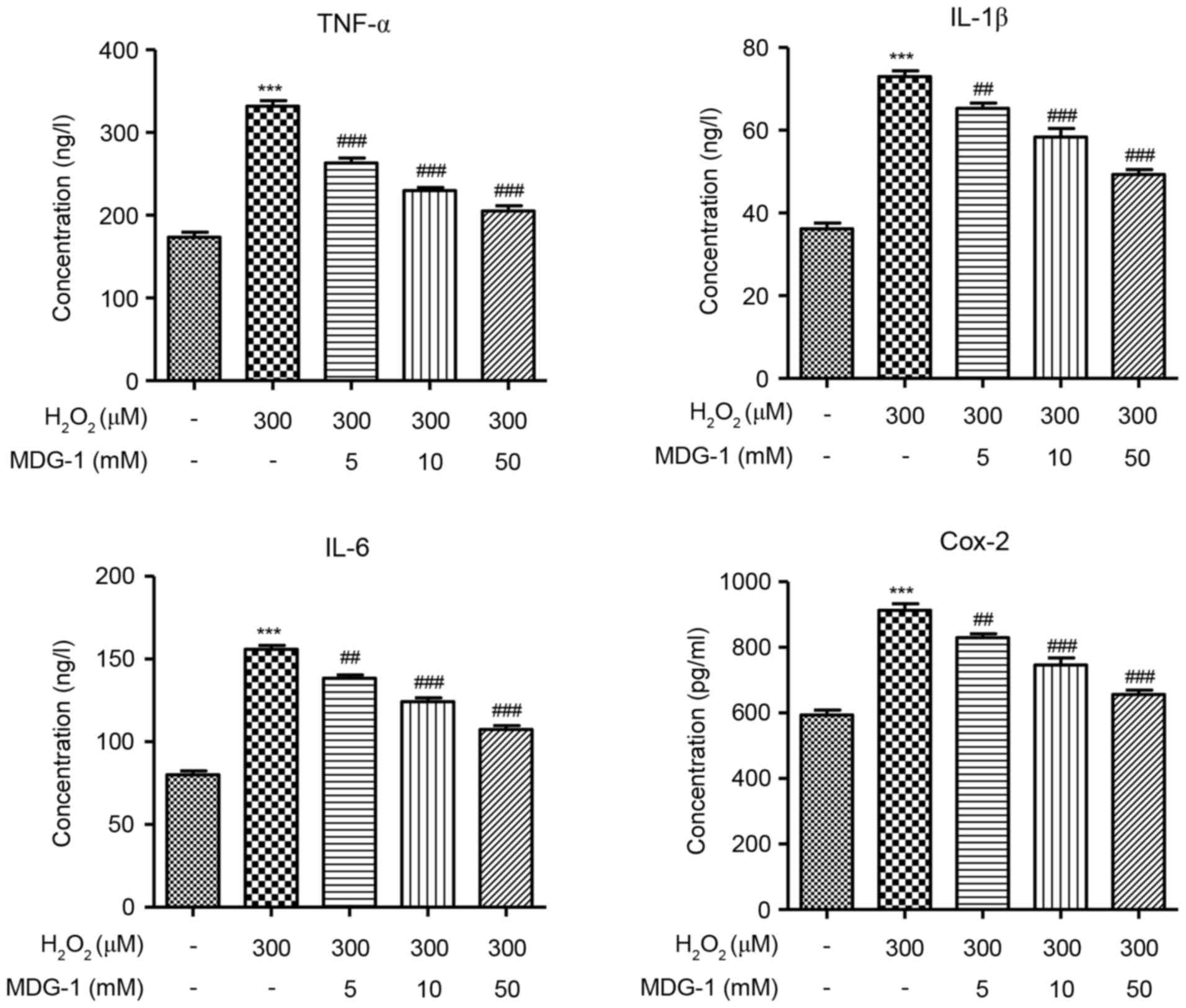MDG‑1 inhibits H2O2‑induced apoptosis and inflammation in human umbilical vein endothelial cells
- Authors:
- Published online on: July 12, 2017 https://doi.org/10.3892/mmr.2017.6957
- Pages: 3673-3679
Abstract
Introduction
Oxidative stress is a key factor in the development of cardiovascular disease (1). A growing body of evidence indicates the close correlation between oxidative stress and the abnormalities in endothelial function. Increased oxidative stress is a major cause of endothelial dysfunction by prolonging cell proliferation (2), disturbing cell cycle (3), increasing the production of reactive oxygen species (ROS) (2), promoting inflammatory responses (4), and activating various intracellular signal transduction pathways (5). Furthermore, systemic and vascular ROS generation modulates inflammatory responses that contribute to microvascular and macrovascular damage (6). Hydrogen peroxide (H2O2), one of the ROS, activates protein tyrosine kinases, resulting in stimulation of downstream signaling events that regulate gene expression and in subsequent modification of cardiovascular cells.
Ophiopogon japonicus is a plant, used in traditional Chinese medicine, and widely distributed in Southeast Asia (7). Previous studies have revealed that O. japonicus exhibitsanti-inflammatory properties and beneficial cardiovascular effects, including anti-ischemia and anti-arrhythmic effects, inhibiting platelet aggregation, protecting endothelium from apoptosis, and improving microcirculation (8,9). MDG-1, a water-soluble polysaccharide extracted from O. japonicus, has been reported to protect cardiomyocytes from hypoxia/reoxygenation-induced damage (10). In addition, MDG-1 presents remarkable anti-ischemic activity and protects cardiomyocytes and human microvascular endothelial cells (HMEC-1) from ischemia-induced cell damage through the sphingosine-1-phosphate/basic fibroblast growth factor/Akt/extracellular signal-regulated kinase (ERK)/endothelial nitric oxide synthase signaling pathway (11).
Human umbilical vein endothelial cells (HUVECs) are the most widely used cell line to study the mechanisms of cardiovascular diseases. Pyruvate protects HUVECs from H2O2-induced dysfunction and improves survival following oxidative stress via blocking the mitogen-activated protein kinase (MAPK) and nuclear factor (NF)-κB pathways (12). Resveratrol protects HUVECs from H2O2-induced oxidative stress and senescence via sirtuin1 activation (13). However, although multiple biological functions of MDG-1 have been identified to date, the potential effect of MDG-1 to the H2O2-induced endothelial injury has not been explored.
The specific aim of the present study was to evaluate the potential protective effect of MDG-1 in HUVECs under oxidative stress. H2O2 was used to induce oxidative stress in HUVECs and to explore the effect of MDG-1 on the endothelium following oxidative stress. The present findings demonstrated that MDG-1 protected HUVECs against H2O2-induced apoptosis and inflammation, by inhibiting capspase-3 and BCL2 associated X (Bax)/BCL2 apoptosis regulator (Bcl-2) ratio expression, as well as inhibiting the secretion of inflammatory factors.
Materials and methods
Cultivation of HUVECs
HUVECs were purchased from the American Type Culture Collection (Manassas, VA, USA). HUVECs were cultured in Dulbecco's modified Eagle's medium (DMEM; Gibco; Thermo Fisher Scientific, Inc., Waltham, MA, USA) containing 10% fetal bovine serum (FBS; Thermo Fisher Scientific, Inc.), 100 U/ml penicillin and 100 µg/ml streptomycin. Cultures were maintained in a 37°C incubator under a humidified atmosphere of 5% CO2/95% air.
H2O2-induced HUVECs injury
Cultured HUVECs were pre-incubated with MDG-1 (5, 10 or 50 mM; Sigma-Aldrich; Merck KGaA, Darmstadt, Germany) for 12, 24 and 48 h prior to H2O2 treatment (100, 300 or 500 µM). Following the indicated time, the medium was removed, and the cells were subjected to the subsequent experiments.
Cell viability assay
The Cell Counting Kit-8 (CCK-8; Dojindo Molecular technologies, Inc., Rockville, MD, USA) was used to assess cell viability in HUVECs. In brief, HUVECs in the logarithmic growth-phase were collected, and 5×104 cells/well were dispensed into 96-well culture plates with 100 µl culture medium. After 24 h of culture, different concentrations of MDG-1 (5, 10 or 50 mM) were added to each well prior to H2O2 treatment (100, 300 or 500 µM). Each of the concentrations above was regarded as one treatment group. Culture plates were then incubated for 4, 6 and 12 h, and cell viability was evaluated by CCK-8, following the manufacturer's instructions. Absorbance was measured at 450 nm using a microplate reader (Molecular Devices, LLC, Sunnyvale, CA, USA). The optical density of indicated groups was used as a surrogate measurement for cell viability.
Apoptosis assay
HUVECs were treated with different concentrations of MDG-1 (5, 10 or 50 mM) prior to H2O2 treatment (100, 300 or 500 µM) for 12 h. Cell apoptosis was then analyzed using the Annexin V-fluorescein isothiocyanate (FITC)/propidium iodide (PI) apoptosis kit (BD Biosciences, Franklin Lakes, NJ, USA) according to the manufacturer's protocol. In brief, HUVECs following treatment were washed three times with PBS, trypsinized, centrifuged (400 × g at room temperature) for 10 min, and resuspended to a final concentration of 5×104 cells/ml in binding buffer containing Annexin V-FITC and PI. Apoptotic cells were then analyzed using a BD Accuri C6 flow cytometer equipped with BD Accuri C6 software (version 1.0.264) (both from BD Biosciences).
Detection of ROS
HUVECs (3×103 cells/well) were cultured on a slide in DMEM and the indicated treatments were performed. Following treatment, the cells were washed three times with PBS, trypsinized, centrifuged (400 × g at room temperature) for 10 min and resuspended to a final concentration of 5×104 cells/ml. The dihydroethidium (DHE; 50 µM; Beyotime Institute of Biotechnology) probe was then added to the cells at 37°C for 30 min, following which the cells were analyzed by flow cytometry (BD Biosciences).
ELISA
HUVECs (5×104 cells/well) were seeded in 6-well culture plates and the indicated treatments were performed. The concentration of each secreted inflammatory factor in the cell supernatant was measured by ELISA, according to the manufacturer's protocol. ELISA kits were purchased as following: Human tumor necrosis factor (TNF-α; 070133h; Shanghai WuHao Trading Co., Ltd., Shanghai, China); human interleukin 1β (IL-1β; DL-IL1b-Hu; Wuxi DonglinSci & Tech Development Co., Ltd., Wuxi, China); human IL-6 (ab46042; Abcam, Cambridge, MA, USA); human cyclooxygenase-2 (Cox-2; ESK5229-48T; Sangon Biotech Co., Ltd., Shanghai, China). ELISA kits were used according to the manufacturer's protocol.
Western blot analysis
HUVECs were harvested, washed twice with PBS, and lyzed with radio immuno precipitation assay buffer (Beyotime Institute of Biotechnology) with freshly added 0.01% protease inhibitor cocktail (Sigma-Aldrich; Merck KGaA) on ice for 30 min. Cell lysates were centrifuged at 1,000 × g for 10 min at 4°C. The supernatant (20–30 µg of protein) was separated on 10% SDS-PAGE and transferred electrophoretically to a polyvinylidene fluoride membrane (EMD Millipore, Billerica, MA, USA). The blots were blocked with 5% skim milk overnight at 4°C, followed by incubation with primary antibodies overnight at 4°C. Rabbit polyclonal antibodies against Bcl-2 (cat. no. sc-492; 1:150) and Bax (cat. no. sc-493; 1:100) were purchased from Santa Cruz Biotechnology, Inc. (Dallas, TX, USA). A rabbit polyclonal antibody against caspase-3 (cat. no. ab2302; 1:500) was purchased from Abcam. A rabbit monoclonal antibody against GAPDH (cat. no. 5174; 1:1,500) was purchased from Cell Signaling Technology, Inc. (Danvers, MA, USA). Blots were then incubated with goat anti-rabbit secondary antibody (Beyotime Institute of Biotechnology) for 1 h at 37°C and visualized using enhanced chemiluminescence reagents (EMD Millipore). Quantity One 4.62 software (Bio-Rad Laboratories, Inc., Hercules, CA, USA) was used to quantitatively analyze protein expression levels.
Statistical analysis
Data were expressed as the mean ± standard deviation of triplicate experiments. One-way analysis of variance, followed by Tukey's post hoc test, was used to analyze the significance of differences between groups with SPSS 19.0 (IBM Corp., Armonk, NY, USA). P<0.05 was considered to indicate a statistically significant difference.
Results
H2O2 induces cell death and apoptosis in HUVECs
To identify whether H2O2 may cause cytotoxicity in vitro, the effect of H2O2 on HUVEC viability was determined using the CCK-8 assay. HUVECs were treated with H2O2 at concentrations of 100, 300 or 500 µM, and exhibited significantly decreased cell viability in a dose-dependent manner at 6 and 12 h (Fig. 1A). A flow cytometry assay was then used in order to assess the effect of H2O2 on HUVEC apoptosis. HUVECs were treated with increasing concentrations of H2O2 for 12 h and exhibited a significant dose-dependent increase in the % of apoptotic cells over total, compared with untreated cells (Fig. 1B and C).
MDG-1 protects from H2O2-induced cell death and apoptosis in HUVECs
To investigate the effect of MDG-1 on H2O2-induced cytotoxicity, HUVECs were pretreated with MDG-1 at different concentrations prior to exposure to 300 µM H2O2 for 12 h. As presented in Fig. 2A, pretreatment of HUVECs with 5, 10 or 50 µM MDG-1 for 12, 24 or 48 h significantly increased cell viability in a dose-dependent manner, compared with cells treated with H2O2 alone. In addition, pretreatment of HUVECs with MDG-1 at concentrations of 5, 10 or 50 mM for 24 h significantly decreased cell apoptosis in a dose-dependent manner, compared with cells treated with H2O2 alone (Fig. 2B and C). These results indicate that MDG-1 pretreatment protected HUVECs against H2O2-induced toxicity.
MDG-1 inhibits H2O2-induced ROS generation in HUVECs
To elucidate the possible mechanisms by which MDG-1 prevented H2O2-induced HUVEC apoptosis, ROS generation was measured in HUVECs that were treated with H2O2 and/or MDG-1. Exposure of HUVECs to 300 µM H2O2 for 12 h significantly enhanced ROS generation compared with untreated cells (Fig. 3). However, pretreatment with MDG-1 for 24 h (at concentrations of 5, 10 or 50 mM) significantly attenuated the H2O2-induced increase in ROS generation in a dose-dependent manner (Fig. 3). These findings demonstrated that the protective function of MDG-1 on HUVEC H2O2-induced toxicity may be associated through its antioxidant effect.
MDG-1 inhibits the H2O2-induced secretion of inflammatory factors in HUVECs
To determine the effect of MDG-1 in the inflammatory response of endothelial cells, secretion of the inflammatory factors TNF-α, IL-1β, IL-6 and Cox-2 was measured by ELISA in HUVECs that were treated with H2O2 and/or MDG-1. The concentration of TNF-α, IL-1β, IL-6 and Cox-2 was significantly increased in H2O2-induced HUVECs, compared with untreated cells (Fig. 4). However, pretreatment with MDG-1 for 24 h resulted in a significant and dose-dependent decrease in TNF-α, IL-1β, IL-6 and Cox-2 secretion, compared with cells induced with H2O2 alone (Fig. 4). These results indicated that MDG-1 pretreatment protected against H2O2-induced inflammatory responses in HUVECs.
Effect of MDG-1 on expression of apoptosis-related proteins
Western blot analysis was performed to detect the protein expression levels of Bax, Bcl-2 and caspase-3 in HUVECs treated with 300 µM H2O2 for 12 h. H2O2 treatment decreased the expression of the antiapoptotic protein Bcl-2, while it increased the expression of the proapoptotic proteins caspase-3 and Bax, compared with untreated cells (Fig. 5). Notably, MDG-1 pretreatment at concentrations of 5, 10 and 50 mM markedly reversed the effects induced by H2O2 treatment on apoptosis-related protein expression, compared with cells treated with H2O2 alone (Fig. 5).
Discussion
Hypoxia-induced injury occurs in many diseases, including sickle cell disease (14), cardiovascular disease (15) and cerebrovascular disease (16). Oxidative stress and increased inflammatory response are two key risk factors for these diseases. MDG-1, a drug extracted from O. japonicus, exerts various effects in vivo, including anti-ischemic properties (17), cytoprotective and proangiogenic effects (11). Therefore, the present study tested the hypothesis that MDG-1 may confer protective effects against H2O2-induced vascular injuries.
To investigate whether MDG-1 mayprotect HUVECs against H2O2-induced cytotoxicity, HUVECs were pretreated with MDG-1 at concentrations 5–50 mM for 24 h prior to exposure to 300 µM H2O2. Notably, the results demonstrated that pretreatment with MDG-1 significantly enhanced HUVEC viability and attenuated HUVEC apoptosis induced by H2O2. The present results also indicated that the protective effects of MDG-1 were time and dose-dependent. The anticytotoxic and antiapoptotic effect of MDG-1 has also been previously reported in high-fat diet-induced obese C57BL/6 mice (18) and ischemia-induced HMEC-1 cells (11).
Another important finding of the present study was that MDG-1 inhibited oxidative stress induced by H2O2 in HUVECs. Treatment with H2O2 elicited a marked increase in ROS generation in HUVECs and this increased ROS production was significantly abrogated by pretreatment with MDG-1. The oxidative stress response may be a potential mechanism by which MDG-1 affects the viability of HUVECs, as it has been recently recognized as a mediator of cell apoptosis. Scavenging of intracellular ROS, such as the hydroxyl radical, or increasing the intracellular levels of reduced glutathione with membrane-permeable antioxidants, significantly blocks apoptosis in endothelial cells (19). Intracellular ROS has been demonstrated to function as a second messenger activating a set of MAPK family members, including ERK1/2 (20), c-Jun N-terminal kinase (21) and p38 MAPK (22). Further studies will be required to elucidate other pathways mediating the inhibition of ROS generation by MDG-1, such as the phosphoinositide 3-kinase/Akt pathway (23).
The inflammatory response is an important contributing factor in H2O2-induced injury. Several inflammatory cytokines are induced by H2O2 in endothelial cells (24). Ophiopogonin D inhibits H2O2-induced secretion of inflammatory factors, such as TNF-α and IL-6, in HUVECs (25). Therefore, H2O2 is a powerful proinflammatory mediator in endothelial cells. In the present study, besides cytotoxicity and oxidative stress, H2O2 treatment also affected the inflammatory response in HUVECs, as evidenced by an increase in the secretion of TNF-α, IL-1β, IL-6 and Cox-2. Of note, MDG-1 pretreatment significantly attenuated this H2O2-stimulated increase in TNF-α, IL-1β, IL-6 and Cox-2 secretion in HUVECs, suggesting that MDG-1 protected HUVECs against H2O2-induced inflammatory response. Cox-2 is a potent proinflammatory mediator that promotes the production of multiple inflammatory factors (26). The Huang Qi herb, which is frequently used in traditional Chinese medicine, has been reported to reduce ischemia/reperfusion-induced injury partly by inhibition of Cox-2 (27). In addition, Cox-2 inhibition by NS-398 can confer anti-inflammatory effects, decreasing IL-6 secretion and increasing IL-10 secretion in a liver damage rat model (28). These data suggest that IL-6 and Cox-2 are proinflammatory factors. However, IL-6 confers cytoprotective effects by diminishing oxidant-mediated endothelial cell injury, mediated partly by a signal transducer and activator of transcription 3 and MAPK kinase 1 signaling (29). These results imply that different cell type, disease model and experimental conditions may affect the precise function of IL-6. Thus, the biological effects of IL-6 on H2O2-induced inflammation require further research in vitro and in vivo.
Pretreatment of HUVECs with catalpol increases expression of Bcl-2, decreases expression of Bax, induces Akt activation and BCL2 associated agonist of cell death (Bad) phosphorylation, and ultimately results in reduced H2O2-induced apoptosis (30). Among the Bcl-2 family, several members, such as Bcl-2 and Bcl-extra large induce cell survival, while other members, such as Bad and Bax, promote cell death (31). Furthermore, it has been demonstrated that members of the Bcl-2 family, which are located on the mitochondrial membrane, can alter mitochondrial membrane permeability and trigger apoptosis (32). H2O2 has been reported to induce cell death in U937 myeloid cells by decreasing the Bcl-2/Bax ratio (33). H2O2 has also been reported to induce apoptosis in PC12 rat adrenal pheochromocytoma cells via activation of caspase-3 (34). In the present study, H2O2 treatment decreased the expression of Bcl-2, while it increased the expression of the proapoptotic proteins caspase-3 and Bax in HUVECs, compared with untreated cells. Notably, MDG-1 pretreatment markedly reversed these H2O2-induced effects.
In conclusion, the present results indicated that MDG-1 may be a potential candidate for preventing oxidative stress-induced damage to endothelial cells. Further studies are required to fully elucidate the potential utility of MDG-1 in protection against cardiovascular dysfunction.
Acknowledgements
The present study was supported by the National Natural Foundation of China (grant no. 81501376) and the Fundamental Research Funds for the Central Universities (grant no. 2042017kf0111).
References
|
Heitzer T, Schlinzig T, Krohn K, Meinertz T and Münzel T: Endothelial dysfunction, oxidative stress, and risk of cardiovascular events in patients with coronary artery disease. Circulation. 104:2673–2678. 2001. View Article : Google Scholar : PubMed/NCBI | |
|
Dong F, Zhang X, Wold LE, Ren Q, Zhang Z and Ren J: Endothelin-1 enhances oxidative stress, cell proliferation and reduces apoptosis in human umbilical vein endothelial cells: Role of ETB receptor, NADPH oxidase and caveolin-1. Brit J Pharmacol. 145:323–333. 2005. View Article : Google Scholar | |
|
Assmus B, Urbich C, Aicher A, Hofmann WK, Haendeler J, Rössig L, Spyridopoulos I, Zeiher AM and Dimmeler S: HMG-CoA reductase inhibitors reduce senescence and increase proliferation of endothelial progenitor cells via regulation of cell cycle regulatory genes. Circ Res. 92:1049–1055. 2003. View Article : Google Scholar : PubMed/NCBI | |
|
Clapp BR, Hingorani AD, Kharbanda RK, Mohamed-Ali V, Stephens JW, Vallance P and MacAllister RJ: Inflammation-induced endothelial dysfunction involves reduced nitric oxide bioavailability and increased oxidant stress. Cardiovasc Res. 64:172–178. 2004. View Article : Google Scholar : PubMed/NCBI | |
|
Brown DI and Griendling KK: Regulation of signal transduction by reactive oxygen species in the cardiovascular system. Circ Res. 116:531–549. 2015. View Article : Google Scholar : PubMed/NCBI | |
|
Ceriello A and Motz E: Is oxidative stress the pathogenic mechanism underlying insulin resistance, diabetes, and cardiovascular disease? The common soil hypothesis revisited. Arterioscl Throm Vas Biol. 24:816–823. 2004. View Article : Google Scholar | |
|
Duan CL, Kang ZY, Lin CR, Jiang Y, Liu JX and Tu PF: Two new homoisoflavonoids from the fibrous roots of Ophiopogon japonicus (Thunb.) Ker-Gawl. J Asian Nat Prod Res. 11:876–879. 2009. View Article : Google Scholar : PubMed/NCBI | |
|
Kou J, Sun Y, Lin Y, Cheng Z, Zheng W, Yu B and Xu Q: Anti-inflammatory activities of aqueous extract from Radix Ophiopogon japonicus and its two constituents. Biol Pharma Bull. 28:1234–1238. 2005. View Article : Google Scholar | |
|
Kou J, Tian Y, Tang Y, Yan J and Yu B: Antithrombotic activities of aqueous extract from Radix Ophiopogon japonicus and its two constituents. Biol Pharm Bull. 29:1267–1270. 2006. View Article : Google Scholar : PubMed/NCBI | |
|
Zheng Q, Feng Y, Xu DS, Lin X and Chen YZ: Influence of sulfation on anti-myocardial ischemic activity of Ophiopogon japonicus polysaccharide. J Asian Nat Prod Res. 11:306–321. 2009. View Article : Google Scholar : PubMed/NCBI | |
|
Wang S, Zhang Z, Lin X, Xu DS, Feng Y and Ding K: A polysaccharide, MDG-1, induces S1P1 and bFGF expression and augments survival and angiogenesis in the ischemic heart. Glycobiology. 20:473–484. 2010. View Article : Google Scholar : PubMed/NCBI | |
|
Lee YJ, Kang IJ, Bünger R and Kang YH: Enhanced survival effect of pyruvate correlates MAPK and NF-kappaB activation in hydrogen peroxide-treated human endothelial cells. J Appl Physiol (1985). 96:792–801. 2004. View Article : Google Scholar | |
|
Kao CL, Chen LK, Chang YL, Yung MC, Hsu CC, Chen YC, Lo WL, Chen SJ, Ku HH and Hwang SJ: Resveratrol protects human endothelium from H(2)O(2)-induced oxidative stress and senescence via SirT1 activation. J Atheroscl Throm. 17:970–979. 2010. View Article : Google Scholar | |
|
Pritchard KA, Ou J, Ou Z, Shi Y, Franciosi JP, Signorino P, Kaul S, Ackland-Berglund C, Witte K, Holzhauer S, et al: Hypoxia-induced acute lung injury in murine models of sickle cell disease. Am J Physiol Lung Cell Mol Physiol. 286:L705–L714. 2004. View Article : Google Scholar : PubMed/NCBI | |
|
Matsushita H, Morishita R, Nata T, Aoki M, Nakagami H, Taniyama Y, Yamamoto K, Higaki J, Yasufumi K and Ogihara T: Hypoxia-induced endothelial apoptosis through nuclear factor-kappaB (NF-kappaB)-mediated bcl-2 suppression: In vivo evidence of the importance of NF-kappaB in endothelial cell regulation. Circ Res. 86:974–981. 2000. View Article : Google Scholar : PubMed/NCBI | |
|
Chrissobolis S and Faraci FM: The role of oxidative stress and NADPH oxidase in cerebrovascular disease. Trends Mol Med. 14:495–502. 2008. View Article : Google Scholar : PubMed/NCBI | |
|
Wang S, Lin X, Wang LY, Ruan KF, Feng Y and Li XY: A polysaccharides MDG-1 augments survival in the ischemic heart by inducing S1P release and S1P1 expression. Int J Biol Macromol. 50:734–740. 2012. View Article : Google Scholar : PubMed/NCBI | |
|
Shi LL, Li Y, Wang Y and Feng Y: MDG-1, an Ophiopogon polysaccharide, regulate gut microbiota in high-fat diet-induced obese C57BL/6 mice. Int J Biol Macromol. 81:576–583. 2015. View Article : Google Scholar : PubMed/NCBI | |
|
Abello PA, Fidler SA, Bulkley GB and Buchman TG: Antioxidants modulate induction of programmed endothelial cell death (apoptosis) by endotoxin. Arch Surg. 129:134–141. 1994. View Article : Google Scholar : PubMed/NCBI | |
|
Watanabe N, Zmijewski JW, Takabe W, Umezu-Goto M, Le Goffe C, Sekine A, Landar A, Watanabe A, Aoki J, Arai H, et al: Activation of mitogen-activated protein kinases by lysophosphatidylcholine-induced mitochondrial reactive oxygen species generation in endothelial cells. Am J Pathol. 168:1737–1748. 2006. View Article : Google Scholar : PubMed/NCBI | |
|
Lin SJ, Shyue SK, Liu PL, Chen YH, Ku HH, Chen JW, Tam κB and Chen YL: Adenovirus-mediated overexpression of catalase attenuates oxLDL-induced apoptosis in human aortic endothelial cells via AP-1 and C-Jun N-terminal kinase/extracellular signal-regulated kinase mitogen-activated protein kinase pathways. J Mol Cell Cardiol. 36:129–139. 2004. View Article : Google Scholar : PubMed/NCBI | |
|
Usatyuk PV, Vepa S, Watkins T, He D, Parinandi NL and Natarajan V: Redox regulation of reactive oxygen species-induced p38 MAP kinase activation and barrier dysfunction in lung microvascular endothelial cells. Antioxid Redox Sign. 5:723–730. 2003. View Article : Google Scholar | |
|
Wang LY, Wang Y, Xu DS, Ruan KF, Feng Y and Wang S: MDG-1, a polysaccharide from Ophiopogon japonicus exerts hypoglycemic effects through the PI3K/Akt pathway in a diabetic KKAy mouse model. J Ethnopharmacol. 143:347–354. 2012. View Article : Google Scholar : PubMed/NCBI | |
|
Cai H: Hydrogen peroxide regulation of endothelial function: Origins, mechanisms, and consequences. Cardiovasc Res. 68:26–36. 2005. View Article : Google Scholar : PubMed/NCBI | |
|
Qian J, Jiang F, Wang B, Yu Y, Zhang X, Yin Z and Liu C: Ophiopogonin D prevents H2O2-induced injury in primary human umbilical vein endothelial cells. J Ethnopharmacol. 128:438–445. 2010. View Article : Google Scholar : PubMed/NCBI | |
|
Yang C, Yang Z, Zhang M, Dong Q, Wang X, Lan A, Zeng F, Chen P, Wang C and Feng J: Hydrogen sulfide protects against chemical hypoxia-induced cytotoxicity and inflammation in HaCaT cells through inhibition of ROS/NF-κB/COX-2 pathway. PLoS One. 6:e219712011. View Article : Google Scholar : PubMed/NCBI | |
|
Chi Y and Kim H: Suppression of cyclooxygenase-2 expression of skin fibroblasts by wogonin, a plant flavone from Scutellaria radix. Prostaglandins Leukot Essent Fatty Acids. 72:59–66. 2005. View Article : Google Scholar : PubMed/NCBI | |
|
Li B, Li YM, Li X, Shi B, He MY, Zhu XL, Zhou WC, Wachtel MS and Frezza E: COX-2 inhibition improves immune system homeostasis and decreases liver damage in septic rats. J Surg Res. 157:43–47. 2009. View Article : Google Scholar : PubMed/NCBI | |
|
Waxman AB, Mahboubi K, Knickelbein RG, Mantell LL, Manzo N, Pober JS and Elias JA: Interleukin-11 and interleukin-6 protect cultured human endothelial cells from H2O2-induced cell death. Am J Respir Cell Mol Biol. 29:513–522. 2003. View Article : Google Scholar : PubMed/NCBI | |
|
Hu L, Sun Y and Hu J: Catalpol inhibits apoptosis in hydrogen peroxide-induced endothelium by activating the PI3K/Akt signaling pathway and modulating expression of Bcl-2 and Bax. Eur J Pharmacol. 628:155–163. 2010. View Article : Google Scholar : PubMed/NCBI | |
|
Olivetti G, Abbi R, Quaini F, Kajstura J, Cheng W, Nitahara JA, Quaini E, Di Loreto C, Beltrami CA, Krajewski S, et al: Apoptosis in the failing human heart. New Engl J Med. 336:1131–1141. 1997. View Article : Google Scholar : PubMed/NCBI | |
|
Sun XM, Bratton SB, Butterworth M, MacFarlane M and Cohen GM: Bcl-2 and Bcl-xL inhibit CD95-mediated apoptosis by preventing mitochondrial release of Smac/DIABLO and subsequent inactivation of X-linked inhibitor-of-apoptosis protein. J Biol Chem. 277:11345–11351. 2002. View Article : Google Scholar : PubMed/NCBI | |
|
Fukamachi Y, Karasaki Y, Sugiura T, Itoh H, Abe T, Yamamura K and Higashi K: Zinc suppresses apoptosis of U937 cells induced by hydrogen peroxide through an increase of the Bcl-2/Bax ratio. Biochem Biophys Res Commun. 246:364–369. 1998. View Article : Google Scholar : PubMed/NCBI | |
|
Yamakawa H, Ito Y, Naganawa T, Banno Y, Nakashima S, Yoshimura S, Sawada M, Nishimura Y, Nozawa Y and Sakai N: Activation of caspase-9 and-3 during H2O2-induced apoptosis of PC12 cells independent of ceramide formation. Neurol Res. 22:556–564. 2000. View Article : Google Scholar : PubMed/NCBI |














